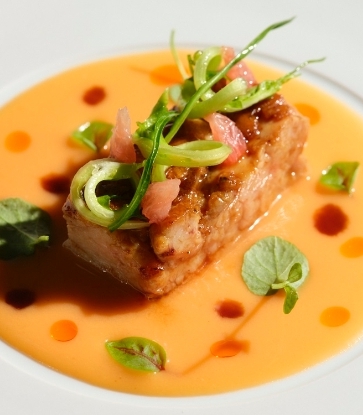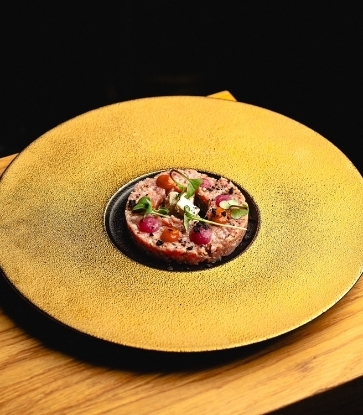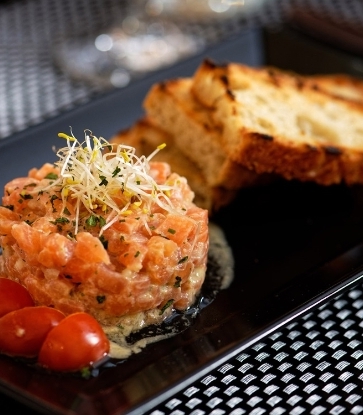A short history of Hungarian cuisine
Under the rule of King Matthias I, byname Matthias Corvinus (1443-1490), Hungary experienced a golden age of gastronomy. The sovereign and his wife, Beatrice of Aragon, born in Naples and accustomed to refined culinary techniques, hosted fabulous feasts inspired by the delicate Italian Renaissance gastronomy. In 1526, after losing the bloody battle of Mohács against the Turks, Hungary was partially occupied by the Ottoman Empire. Through the Balkans, the Turks introduced the New World’s chili peppers known today as paprika. Other Hungarian staples are of Turkish ancestry, such as stuffed peppers with rice, stuffed cabbage with meat, coffee and even strudel (often thought of as an Austrian dessert, but actually developed from the Turkish baklava in Hungary).At the turn of the 18th century, Hungary fell under the Habsburg rule and was later attached to Austria, forming the powerful Austrian-Hungarian Empire, which left its mark on the local gastronomy as well. The deliciously refined Hungarian pastries are a blessing from the 19th century Viennese love for cakes and the famous veal or pork schnitzel, served with a classic cucumber salad, is another Austrian dish adored by today’s Hungarians.

The long years of communism (1945-1989) are often equalled with the dark age of Hungarian cuisine; yet, in spite of the persecution of small privately-owned farms, the local traditions did survive. The collapse of the dictatorship brought accelerated capitalism to a country used to collective farming producing local food for everyone. In the 1990s, the food-processing industry created an urge to buy affordable but low-quality ingredients. For all of these reasons, it is highly remarkable to see the current development of contemporary Hungarian cuisine, especially in its fine-dining form.
Under the impulse of young, open-minded, dynamic chefs and restaurant owners, the emerging culinary scene of Budapest is becoming truly exciting. Ten years ago, fine-dining pioneers had a hard time finding constantly available high-quality local ingredients. According to most young chefs, today’s challenge is to educate the Hungarian palates to smaller portions and to sophisticated experimentations and tastes, in order to reach an international level in the fine dining scene without heavily relying on a foreign clientele.
A selection of Hungarian culinary traditions
A landlocked country, Hungary gets its protein from local farmed beef, pork and poultry, game meat, freshwater fish (pike perch, carp, trout and catfish) and beans. The continental climate provides the ideal conditions to grow a variety of fruit and vegetables. Cherries (black-heart or sour), onions and paprika are the most representative of the local produces. The luscious forests provide Hungarian kitchens with mushrooms. Young winemakers take Hungarian traditions to an international level of quality, forming a new scene which spreads much beyond the name of the refined, sweet Tokaj aszú. Excellent Hungarian dry white wines, and a few sunny, hearty reds attract crowds of wine lovers and gourmets.
Paprika
The gold of Hungary, the spice which dominates goulash and most stews, soups, sausages or spreads, was imported in the 17th century from the Americas. It only became popular in the 19th century, after the Pálfy brothers were able to cultivate a sweet version of the scorchingly hot chili pepper. Its fabulous red color brings brightness and joy to just any dish, especially on cold winter days. Though the Hungarians favor the sweet version of paprika, the spice powder ranges from very hot to sweet, from red to orange and rose. Where to get it in Budapest : you can buy it at any local grocery store, of course, but it’s fun to visit the local market halls in Budapest, such as the Great Market Hall in the city center, located on the Pest side of the Liberty Bridge.
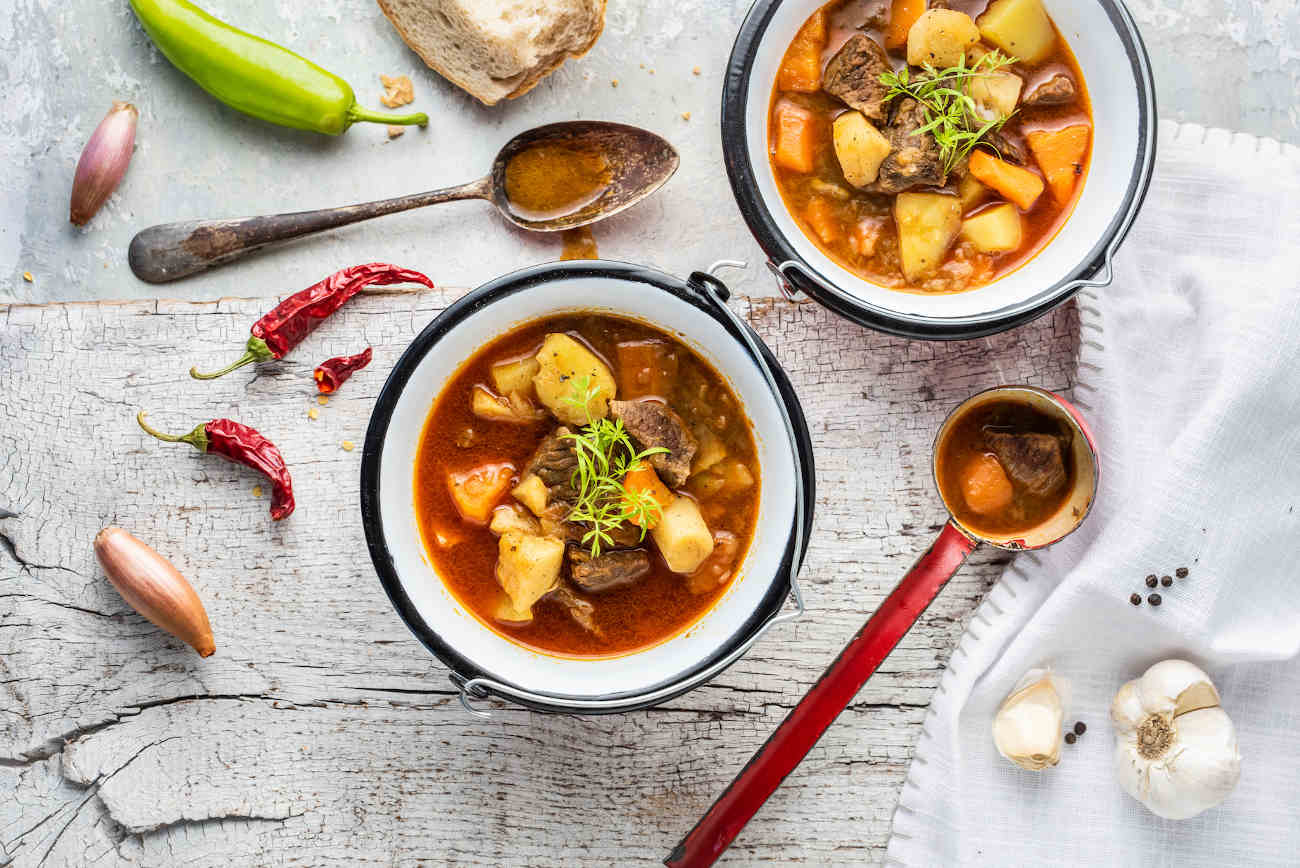
Goulash vs Pörkölt
What foreigners call goulash is actually pörkölt, which is the original recipe of the goulash: a thick, paprika-laced stew made with cubed beef, mutton, pork, chicken or offal. A similar recipe, equally popular in Hungary, is chicken paprikash, a very popular bright orange chicken stew, to which a generous amount of sour cream is added.Confusingly, a much lighter soup made with beef stock and packed with paprika powder is what Hungarians refer to when they use the word goulash. The traditional sides to goulash are the egg dumplings (galuska) or egg "barley" (tarhonya) if you get it served at a restaurant ; at home, Hungarians eat goulash soup with bread. Soups are a real cult in Hungary. A meal isn’t complete without one, whether it’s prepared with veggies, meat or fish, like the Baja fish soup, made with carp, or the Szeged fish soup prepared with multiple kinds of fish. Hungarians enjoy eating soup so much that they also love it in the summer, whether it’s a chilled savory soup or a sweet fruit soup.
Where to get it in Budapest : Though Hungarians prefer cooking it at home and swear that their grandma’s version is unsurpassable, you can try goulash soup in any traditional, unfussy restaurant in town. However, we highly recommend tasting the fine-dining version at Spago or the more traditional, bistro-style yet masterful goulash soup at Stand25.
Foie gras
Few people know that Hungary is the second producer of foie gras in the world after France. Duck or goose liver addicts will love discovering this beautiful tradition in many family-style or fine-dining restaurants at a much affordable price than in Paris. It is usually served as a terrine, like in France, or as a lighter mousse, but the truly unbeatable Hungarian way is the lightly seared foie gras, served hot with a homemade brioche.Where to get it in Budapest : As a classic French-style terrine at Felix with Tokaj jelly, or seared and sprinkled with sparkling meringue at Rumour. Textúra’s foie gras mousse comes disguised under a delicate golden fish biscuit.
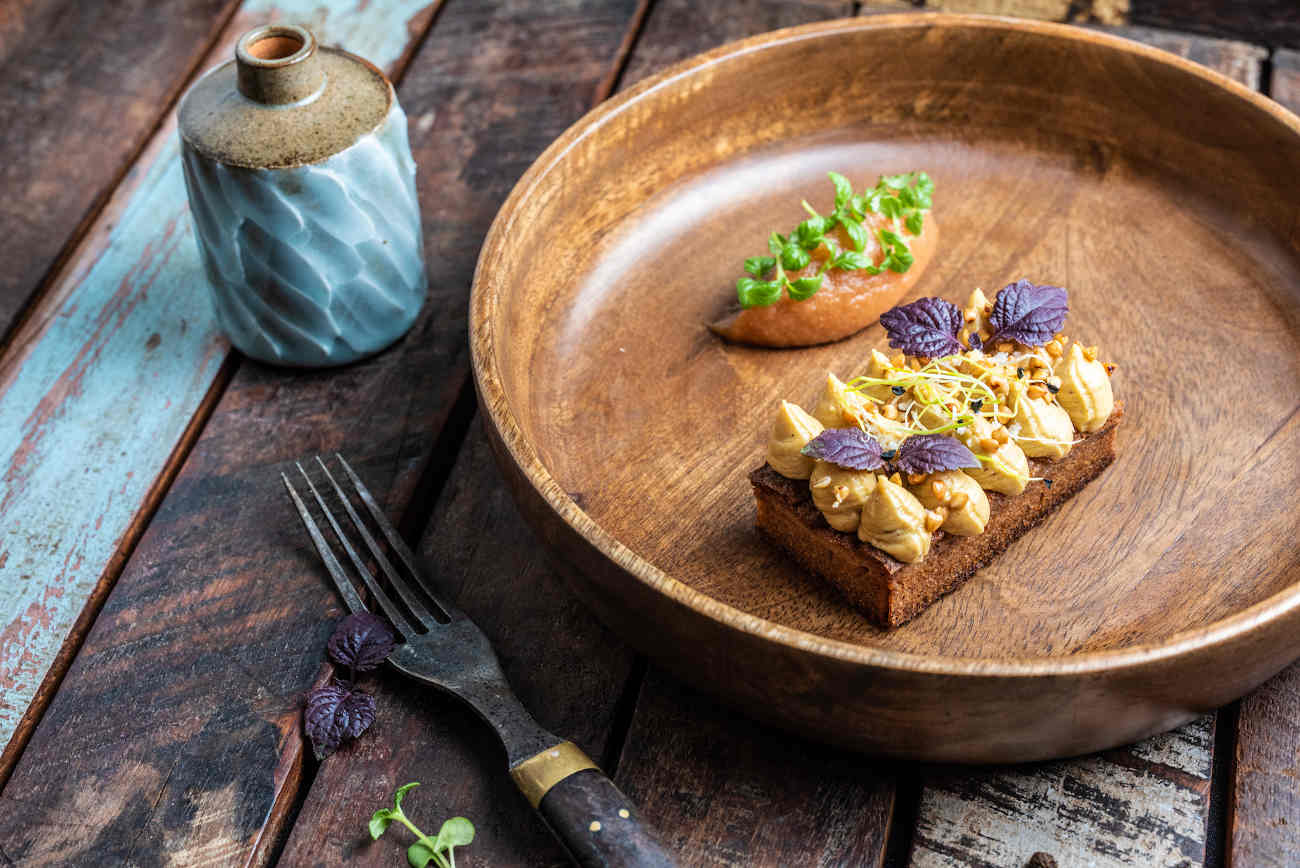
Pickles
Like in many countries where the winters can be harsh and unforgiving, the Hungarian people have wisely learned how to preserve vegetables for the winter. In winter, vegetable pickles are traditionally served as a side, the way one serves a side of salad in may western countries (salad courses do not exist in Hungary). The international obsession for fermentation since the success of Scandinavian fine-dining experimentations has revived the beautiful Hungarian countryside tradition.Where to get it in Budapest : Mák serves excellent pickles and uses fermentation in many dishes, such as horseradish, tangerine peel, or fermented garlic.
Pasta
Interestingly, the Hungarian pasta is usually sweet and served as a second course, coated with poppy seeds and icing sugar, for example. Other surprising options could be pasta with cabbage and sugar, or with bacon and icing sugar. Those not accustomed to these Hungarian staple combinations might prefer trying the egg dumplings or noodles (galuska) and the egg « barley » (tarhonya) which does not contain any barley but mimics the shape of the cereal. Made with flour, eggs and water, these very simple grandma-style noodles are pure comfort food, especially served with sour cream and vegetables.Where to get it in Budapest : St. Andrea has a fabulous egg barley side dish to go with its exquisite fallow deer stew (dám pörkölt). Don’t look away from the sweet pasta, and try the stunning apple ravioli at Pasztell !

Cured meat
Traditionally served for breakfast with bread and cheese, Hungarian cured meat is diverse and excellent. The famous local mangalica pig, also known as the « kobe beef orf pork », provides an incredibly flavorful marbled meat. Szalonna can be compared to lardo or pig belly fat, and kolbász is a cured sausage featuring a blend of fat and meat laced with a good hand of spice.Where to get it in Budapest : every farmer’s market has a stand where you can try cured meat in Budapest. For an elegant fine-dining option, try Laurel’s mangalica with quince and onions.
Sweets and pastries
Most restaurants in Hungary don’t serve cakes for desserts. Here, cakes are an experience and a meal in themselves, and one will find fabulous windows of Dobos torte (sponge cake layered with chocolate butter cream and topped with caramel), Gerbeaud slice (layered cake with walnuts and apricot jam, topped with chocolate) or vanilla custard puffed pastries (krémes) in traditional cafés and tea rooms all over Budapest. Restaurant desserts include the extremely popular túrógombóc (cottage cheese dumplings). A traditional sweet usually made by Hungarian grandmothers, it has now reached stardom as many chefs around town compete to make the airiest, fluffiest and most exquisite version of it. Somlói galuska, a rum-infused sponge cake with vanilla custard, whipped cream and chocolate cream, is a recent invention from the 1950s that can be found on almost every restaurant’s menu in Hungary. The Hungarian crepes or palacsinta, which can be sweet or savory, are equally popular.
Where to get it in Budapest : The traditional coffee houses from the Golden Era of the AustrianHungarian Empire serve the best cakes in a luxurious, charmingly traditional environment. Every visit of Budapest should include a stop at Gerbaud, Ruszwurm or New York Café. Make sure you become a túrógombóc expert by comparing fine-dining chefs’ versions at Stand25 and St. Andrea. A refined version of somlói is to be found at Spago.
Hero Image : Paprika / Hungarian Tourism Agency








